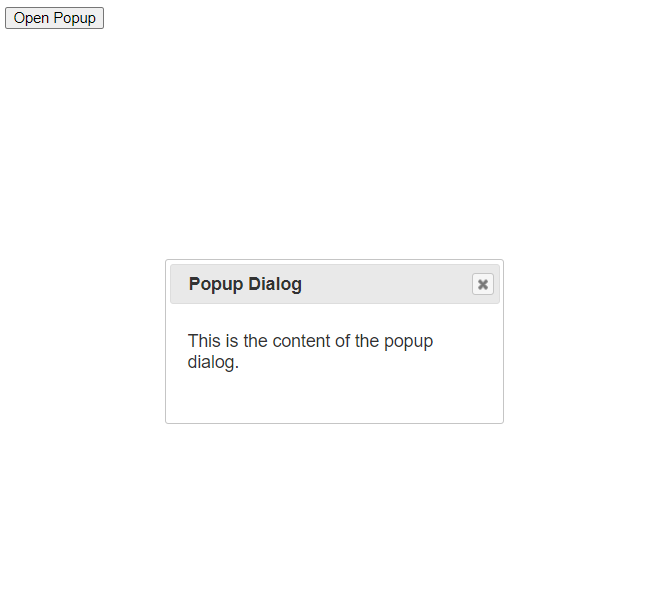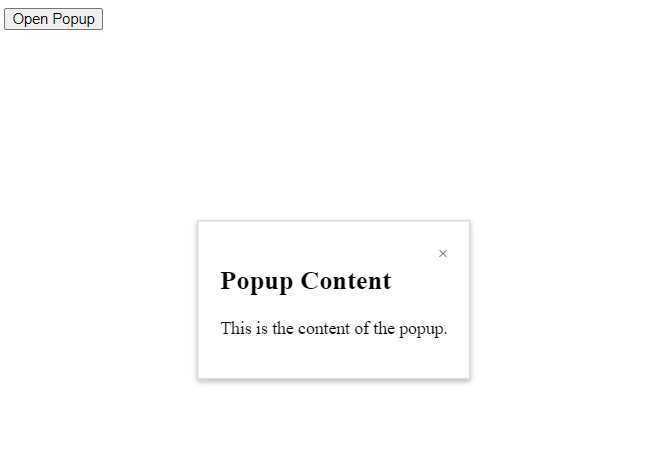Introduction:
Popup windows are a commonly used feature in web development that allow for the display of additional content or actions without navigating away from the current page. jQuery, a popular JavaScript library, provides an efficient and user-friendly way to implement popup windows. In this blog post, we will explore multiple methods to create popup windows using jQuery, complete with code examples, detailed explanations, and their respective outputs.
Method 1: Using the jQuery UI Dialog Widget
The jQuery UI Dialog widget is a powerful tool for creating popup windows. It offers a wide range of customization options and allows developers to define their own content and behaviors for the popup. Here's an example of how to create a basic popup window using the Dialog widget:
<!DOCTYPE html>
<html>
<head>
<link rel="stylesheet" href="https://code.jquery.com/ui/1.12.1/themes/base/jquery-ui.css">
<script src="https://code.jquery.com/jquery-3.6.0.min.js"></script>
<script src="https://code.jquery.com/ui/1.12.1/jquery-ui.js"></script>
</head>
<body>
<button id="myButton">Open Popup</button>
<div id="myDialog" title="Popup Dialog">
<p>This is the content of the popup dialog.</p>
</div>
<script>
$(document).ready(function() {
$("#myButton").click(function() {
$("#myDialog").dialog();
});
});
</script>
</body>
</html>
In this code, we include the necessary CSS and JavaScript files from the jQuery UI library. When the "Open Popup" button is clicked, it triggers the click event and opens the myDialog div as a popup dialog using the dialog() function provided by jQuery UI.
Output:

Method 2: Creating a Custom Popup Window
If you require more control over the appearance and behavior of your popup window, you can create a custom implementation using jQuery. Here's an example:
<!DOCTYPE html>
<html>
<head>
<title>Popup Example</title>
<link rel="stylesheet" href="https://code.jquery.com/ui/1.12.1/themes/base/jquery-ui.css">
<style>
#myPopup {
display: none;
position: fixed;
top: 50%;
left: 50%;
transform: translate(-50%, -50%);
background-color: #fff;
padding: 20px;
border: 1px solid #ccc;
box-shadow: 0 2px 5px rgba(0,0,0,.3);
}
#closeButton {
float: right;
cursor: pointer;
}
</style>
</head>
<body>
<button id="myButton">Open Popup</button>
<div id="myPopup">
<span id="closeButton">×</span>
<h2>Popup Content</h2>
<p>This is the content of the popup.</p>
</div>
<script src="https://code.jquery.com/jquery-3.6.0.min.js"></script>
<script src="https://code.jquery.com/ui/1.12.1/jquery-ui.js"></script>
<script>
$(document).ready(function() {
$("#myButton").click(function() {
$("#myPopup").fadeIn();
});
$("#closeButton").click(function() {
$("#myPopup").fadeOut();
});
});
</script>
</body>
</html>
In this code, we have a button with the ID myButton, which is used to open the popup. The popup itself is represented by a <div> element with the ID myPopup. It contains some content along with a close button represented by the <span> element with the ID closeButton.
We use CSS to style the popup and the close button. The jQuery UI library is included to provide the fade-in and fade-out animations.
The JavaScript code inside the $(document).ready() function sets up event handlers for the button click and close button click. When the button is clicked, the popup is faded in using the fadeIn() method. When the close button is clicked, the popup is faded out using the fadeOut() method.
Output:

Conclusion:
In this blog post, we explored multiple methods to create popup windows using jQuery. We started with the jQuery UI Dialog widget, which offers extensive customization and flexibility. Then, we discussed creating a custom popup window, allowing for more control over the appearance and behavior. By leveraging these methods and tools, developers can enhance user interactions and create engaging popup windows for their web applications.


Comments (0)